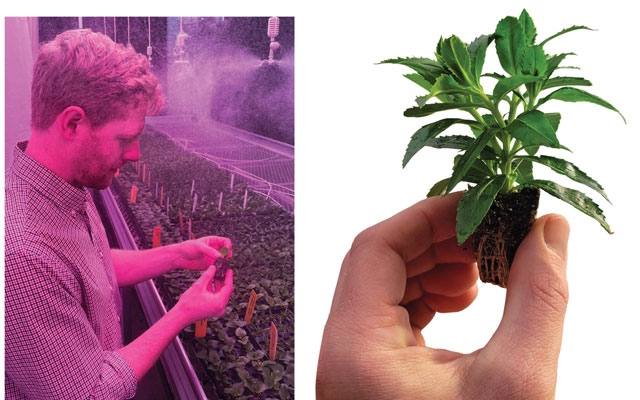4/1/2024
Tech On Demand Team Profile: Dr. Nathan Jahnke
Bill Calkins

Research drives innovation. Innovation leads to improvement. This is true in most aspects of business—and it is integral to the success of greenhouse professionals producing high-quality crops using the most cutting-edge methods. Applied research in the greenhouse is where Ball Seed’s Culture Research Manager Dr. Nathan Jahnke truly shines.
Nathan leads a team whose dedication to finding better ways to grow plants is top of mind daily. What Nathan learns is directly applicable to Ball Seed’s grower customers—whether directly improving how they grow their own crops or leveling up production strategies for the greenhouses that supply them.
Nathan said his short-term goals are continuing to hone his knowledge to be a well-informed researcher and continuing to contribute to the industry, guiding greenhouse professionals toward innovative solutions. These goals have emerged and solidified since he joined Ball four years ago after completing his doctoral degree at North Carolina State University.
“My doctorate is in postharvest handling of floriculture crops,” he said. “I focused on unrooted cuttings and cut flowers.”
This understanding of processes leading to successful delivery and performance of flowering crops helps Nathan understand how plant growth happens, and how it can be controlled and optimized.
 Pictured: Nathan’s research studying tissue culture acclimation best practices has led to improved protocols for many growers in North America. As use of TC inputs expands, these findings will lead to increased performance and reduced losses. ● Culture research requires close attention and countless hours taking readings and measurements. Nathan’s dedication and professionalism means he spends a lot of time in the Ball research greenhouses gathering trial data.
Pictured: Nathan’s research studying tissue culture acclimation best practices has led to improved protocols for many growers in North America. As use of TC inputs expands, these findings will lead to increased performance and reduced losses. ● Culture research requires close attention and countless hours taking readings and measurements. Nathan’s dedication and professionalism means he spends a lot of time in the Ball research greenhouses gathering trial data.
Some of his recent projects—completed and in progress—mirror trends in the industry and showcase his innovative nature. Nathan has become known around the Ball companies and industry for his findings related to tissue culture (TC) acclimation. TC is rapidly becoming a relevant input for young plant production and new research findings have taken acclimation of TC to the next level, including new approaches to controlling temperature, humidity and light (see the sidebar “Talking TC with Nathan”).
Some other projects Nathan has worked on and continue to fine tune include rehydration of cuttings to reduce shrink in propagation and understanding how LED lighting technologies impact plant growth—from a very scientific perspective. Much of his work on LEDs has been in collaboration with the research team at Michigan State University, lighting experts at Signify and growers trialing various types of greenhouse lighting. His team also has been conducting trials to help growers improve young plant branching.
“Strategies to reduce or eliminate manual plant pinching will not only lower labor costs, but also reduce disease risks associate with pinching,” Nathan said. “The end goal is higher-quality plants grown with fewer touches.”
 Pictured: Nathan’s hands-on research approach results in findings that benefit Ball Horticultural Company’s internal stakeholders, as well as Ball Seed’s grower customers. ● Branching trials currently underway with Nathan’s research team are already showing positive results that could reduce manual pinching with some crops—leading to reduced labor and improvements in quality.
Pictured: Nathan’s hands-on research approach results in findings that benefit Ball Horticultural Company’s internal stakeholders, as well as Ball Seed’s grower customers. ● Branching trials currently underway with Nathan’s research team are already showing positive results that could reduce manual pinching with some crops—leading to reduced labor and improvements in quality.
As Nathan and his team work with other divisions (including breeding companies) within Ball and Ball Seed’s customers in North America, their eyes are always on ways to take challenges and problems with few existing answers and develop solutions.
“The outcome of my research must be practical and applicable,” he explained. “And then the next step is delivering these solutions into the hands of the people who put them into action.”
Nathan’s research role truly elevates internal stakeholders, as well as Ball Seed’s grower customers.
“I can research any problem on any product to support our customers,” he said. “In addition, being a part of the technical services team allows me and other team members to quickly and effectively share research findings on a broader scale.”
Some tactics to disseminate information to the industry include writing articles, presenting at industry events and conferences, partnering with leading university research teams, sharing content via videos, and collaborating with grower peer groups.
When meeting Nathan and talking about floriculture research, it becomes quite evident that he loves his job and also has a passion for plants. He explains this saying, “I get to talk to a lot of different people about a lot of different things. Sharing my research is where the plants and the people come together.”
As any good researcher tends to do, Nathan has short-term and long-term goals for what he plans to dig into and challenges his team seeks to solve. Looking down the road a few years, he would love to have a new, state-of-the-art research greenhouse onsite at Ball to house trials.
“A greenhouse with the latest technology would allow us to conduct a lot of different research to benefit our customers and the industry as a whole,” he said. “We could use it to create multiple environments to simulate what our technical services team sees in the field.”
Fun facts: Nathan had a small greenhouse growing up and this sparked his passion for plants and learning how they grow. He’s also played violin since first grade.
Talking TC With Nathan
Join Nathan and Deanna Felton, longtime Production and Propagation Manager at Sunbelt Greenhouses in Georgia, for a seven-part video miniseries diving deep into tissue culture production.
TC plantlets are not like unrooted cuttings, plugs or liners—they’re quite different and require extra attention in the early stages of propagation. Once acclimated, most growers do find that subsequent processes are much the same as plugs or liners. Thankfully, there’s significant research underway and new strategies for TC production being shared. Now is the time to begin learning ways to produce TC-raised crops efficiently and effectively, and refining techniques that will allow your operation to benefit from this new frontier.
Nathan on URCs
Producing high-quality finished plants starting from unrooted cuttings (URCs) can be considered a manufacturing project. Before young plants arrive, preparation, planning and sanitation processes must be in place. Creating receiving and storage protocols helps ensure URCs get off to a good start and prioritizing sticking based on the nuances of each crop can eliminate costly issues. Once stuck, the earliest stages of production (all the way until roots start forming) depend on careful management of greenhouse environments and crop nutrition.
Nathan and fellow Ball technical services specialist Dr. Todd Cavins take viewers through the entire process in a Tech On Demand 13-part video miniseries titled “Success with Cuttings: Optimize Young Plant Production.”